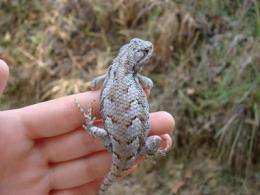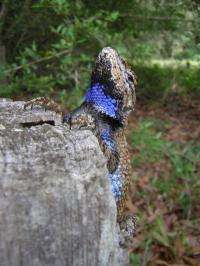Stress hormones help lizards escape from fire ants

New research shows that when some fence lizards are attacked by fire ants they "stress out"-- a response that actually helps the species to survive by heightening the animal's awareness of imminent danger. Tracy Langkilde, assistant professor of biology at Penn State University, found that lizards living in areas of the southeastern United States, where large numbers of fire ants also live, have elevated levels of stress hormones, called glucocorticoids.
The stress-hormone study comes on the heels of Langkilde's earlier studies of lizard behavior. In 2009, she showed that native fence lizards responded to their scary new invaders -- fire ants -- in one of two ways. Some lizards relied on camouflage and stayed perfectly still -- the traditional response of their ancestors to threats by other animals. Other lizards, however, took a novel approach when faced with fire ants. They twitched and ran away. While the traditional, "stay still" response worked in the past, and continues to work for lizards threatened by other sorts of predators, it does not work for lizards facing an onslaught of vicious fire ants. "Non-responsive lizards get stung more and are less likely to survive to reach reproductive age, when they would be capable of passing their non-reacting genes on to offspring," Langkilde said. On the other hand, those lizards who have the "twitch and flee" response get stung less because they manage to flick the insects away. Such lizards also tend to stay alive long enough to reproduce and to pass on their "twitch and flee" genes.
Now, Langkilde's more recent study -- measuring stress-hormone levels in lizards -- adds an important piece of information to adaptive-behavior research. In "twitch and flee" lizards, stress hormones appear to mobilize the animal's energy, fueling its response and encouraging appropriate escape behavior. "The negative impacts of stress on health have received much research attention," Langkilde said. "However, stress may play a vital role in facilitating adaptive responses to threatening situations." Langkilde's research provides clues to the survival benefits of stress and suggests that the absence of an appropriate stress response may reduce an animal's ability to survive invasion. "Rather than just being a cause for concern," Langkilde said, "elevated levels of physiological stress within invaded lizard populations may be playing an important role in driving adaptations to novel threats."

In the United States, eastern fence lizards have a huge geographical range from New York and Pennsylvania to Florida and westward to Texas, but the range of fire ants currently is limited to states with warmer climates. One of the many modern-day challenges confronting scientists is to understand the impact of invasive species on natural habitats and native populations. In the southern United States, for example, non-native imported fire ants spread rapidly, destroy crops, and sting humans and animals alike. "The interaction between invasive fire ants and native lizards provides an excellent opportunity to understand the role stress plays in facilitating adaptive behavioral responses to new threats," Langkilde said.
Langkilde will present this research in a session titled "Stress and Invasion: factors influencing the escape behavior of native fence lizards in response to introduced fire ants" on Monday, 2 August 2010 at the Ecological Society of America's (ESA) 95th Annual Meeting in Pittsburgh, Pennsylvania.
Provided by Pennsylvania State University
















